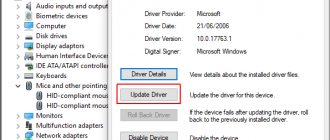10/11/2016 windows | router setup | laptops
This manual provides details on why a Wi-Fi connection may not work on a laptop in Windows 10, 8 and Windows 7. The following describes step by step the most common scenarios related to the performance of a wireless network and how to solve them.
Most often, problems with Wi-Fi connections, expressed in the lack of available networks or access to the Internet after connection, occur after updating or installing (reinstalling) the system on a laptop, updating drivers, installing third-party programs (especially antiviruses or firewalls). However, other situations are also possible that also lead to these problems.
The material will discuss the following main options for the “Wi-Fi not working” situation in Windows:
- I can’t turn on Wi-Fi on my laptop (red cross on the connection, message that there are no connections available)
- The laptop does not see your router’s Wi-Fi network, but sees other networks
- The laptop sees the network, but does not connect to it
- The laptop connects to the Wi-Fi network, but pages and sites do not open
In my opinion, I have indicated all the most likely problems that may arise when connecting a laptop to a wireless network, let’s begin to solve these problems. You may also find useful materials: Internet stopped working after upgrading to Windows 10, Wi-Fi connection is limited and without Internet access in Windows 10.
Is it a laptop or a router?
If the laptop does not connect to the Wi-Fi network, you need to determine which device is the source of the problem - the laptop itself or the router that distributes the wireless Internet.
To check, you need to try connecting to the wireless network from another computer or mobile device. If the check shows that Wi-Fi does not function from other gadgets, then the reason must be looked for in the Wi-Fi router. If the connection is successful, there is no doubt that the source of the problem is in the laptop.
The Internet or Wi-Fi network disappears on all PCs and other devices (the problem is in the router)
A number of reasons for the problem of disabling WiFi on specific devices - laptops and desktop PCs - were discussed above. But if you notice that the connection is disconnected on all devices at once, then it is useless to look for the reason in any one, the router or Internet provider is to blame.
You can try to distinguish who is to blame - your equipment (router) or the provider. But it is not always possible to do this on your own.
Follow these steps:
- Try to position yourself close to the router so that you can see its indicators (lights). If you see that all the indicators go out when you disconnect from WiFi, then the router is clearly to blame. He probably has a nutrition problem. You can check the quality of the power cable contact to see if it is damaged. Or there is an internal hardware malfunction of the equipment. It may even overheat. Then either take it to the service center or exchange it for a new one.
- If you see that the light indicating the presence of an Internet connection goes out, then there may be a problem with the provider cable that connects to the router. Check to see if it's pinched anywhere? Normal contact with the router? If your provider is a mobile operator, then frequent outages are very likely, especially in areas with poor signal reception. In this case, you most likely will not lose your Wi-Fi connection completely, but you will not have Internet access and will see the “No Internet access” error on the network connection icon.
- If you see that the indicator on the router goes out, indicating the operation of the Wi-Fi network, then this could be either a hardware or software malfunction of the router (resetting the settings or updating its firmware may help).
- Try to reduce the load on the network by disabling downloading/sharing via torrents, if this is important to you. Increased network load is one of the reasons for disconnecting from Wi-Fi.
- Reset your router. This is hello to a full rollback to factory settings. Please note that you will need to configure it again! Nevertheless, this option helps in some cases. Resetting occurs as standard on any routers: there is a “pressed-in” Reset button on the side or back. With the router turned off, press and hold it (for example, with a pencil) for 10 seconds, then turn the device on again. Now you will need to reconfigure your Wi-Fi connection and test the connection.
- The router firmware may be to blame for all network troubles. Firmware is the software for the proper functioning of all hardware functions. If you have a more or less new model of router, then perhaps there is fresh firmware for it, which fixes a number of problems (yours may be among them). You can check whether there is a new version and, at the same time, update it through the router’s web interface (you can enter there at the address indicated on the device sticker, for example, 192.168.0.1). You can also check the availability of new firmware on the device developer’s website, similar to what I showed above for searching for WiFi drivers.
Checking the hardware enablement of the adapter
If the problem is in the laptop, you need to start gradually identifying the reason that caused the Wi-Fi to not work. You should start by checking that the adapter is enabled on the device:
- Check to see if the wireless adapter is turned on. Modern models have a light indicator - when the module is turned on, it should light up in green, otherwise (it doesn’t light up at all or lights up in red) it needs to be turned on. In most cases, indicators are installed on the laptop body panel (less often, next to the touchpad or on the monitor body).
- To turn on the network module, press the key combination Fn and the system F with the corresponding icon in the form of an antenna. If there is no such icon, press the typical Fn + key combination for a specific laptop brand: F2 – Asus; F3 – Acer; F5 – Fujitsu, Lenovo; F9 – Samsung; F12 – HP, Dell.
- We check whether the module is enabled or not. If the problem is successfully resolved, the indicator turns on or the red indicator changes to green.
- We make a new attempt to connect to the wireless network.
Device hardware connection
All modern laptops are equipped with a special key to turn on/off the wireless connection. In addition, they have light indicators that indicate the presence or absence of a connection. If Wi-Fi is available, the indicator lights up white, green, blue or some other color that evokes the association of serviceability. If the wireless network is disabled, the indicator color will be red or will not indicate anything at all.
Sometimes the indicator and the key are combined, and the button is placed on the keyboard and is also combined, for example, with “F2”.
Using these keys you can turn the wireless connection on or off. This is done in approximately the same way; there may be minor differences depending on the specific model. If the key is located in a specially designated place for it, it must be set to the “ON” position.
If it is combined with the functional buttons of the laptop keyboard, you need to press the combination “fn” + “keyboard button”.
It happens that the keyboard does not show which button to combine pressing “fn”. For example, because the inscriptions have been erased or the manufacturer considered it unnecessary to apply the appropriate markings. In this case, you can try to figure out the correct combination by trial and error or use the standard options for certain models:
- Fn+F2 for Asus, Dell Gigabyte models;
- Fn+F5 on Fujitsu brand laptops;
- Fn+F12 – HP.
- Fn+F3 – Acer;
As we sort through the possible options, we look at the reaction of the indicators on the laptop and the changes taking place in the Windows interface, in particular in the taskbar. If we don’t see a positive result, we continue to look for the problem.
Problem with hardware enablement
If Wi-Fi does not start as a result of a hardware failure, you need to perform a soft launch directly from the operating system. To carry out this process, we adhere to the following algorithm of actions:
- Windows 7 and 8: Start (for Windows 8, keyboard shortcut Win+X) – Control Panel – Network and Internet – Network and Sharing Center – Change adapter settings (left panel)
- Windows 10: keyboard shortcut Win+X – Network Connections – Network Control Center..., and then by analogy above.
Near the “Wireless Network Connection” icon (“Wireless Network”), when the adapter is disabled and Wi-Fi is not functioning, the icon, as a rule, is not highlighted (i.e., remains gray).
Right-click on the icon. When the list opens, you need to select “Enable”. If the procedure is followed correctly, the wireless adapter turns on and the connection icon changes color.
After that, we look for the required one in the list of available wireless networks and connect to it.
How else to set up wireless Internet
In addition to the solutions already mentioned, the following tips can help fix network connection problems:
- reboot the device;
- checking the WLAN auto-configuration service;
- adjusting settings in a special program from the laptop manufacturer, which is responsible for managing function keys, power and wireless networks (if such a utility is installed);
- removing the Wi-Fi adapter from Device Manager and then restarting the computer.
Failures when connecting to the network and accessing the Internet do not always occur on the laptop side, so before resorting to extreme measures or completely disassembling the device to replace the Wi-Fi module, try restarting the router, perhaps after this the connection problem will disappear.
Missing (or outdated) drivers
Quite often the following happens on a laptop: Wi-Fi is turned on, but the device does not detect the network. In more than 70% of cases, the reason for not being detected or not connecting to the network is the lack of necessary drivers.
This often happens after reinstalling the operating system, as a result of which various problems can occur: the adapter will not function well or the wireless device will be physically located in the system, and Windows will not know about it.
To determine the presence of a driver, you need to perform a number of actions:
- Go to Device Manager. This is done like this: right-click on the “This PC” icon on the desktop, select “Manage” and select “Device Manager” in the left column.
- Find the line “Network adapters”, and in the expanded list of connected devices, select the line with the wireless network adapter (or Wireless). Next to it should be the name of the network card manufacturer.
- Once you find what you need, right-click and select Properties. There should be a message here indicating that this device is working normally. However, such information cannot yet serve as a guarantee that the necessary driver is installed on the computer and Wi-Fi is turned on correctly.
- Go to the Driver tab. Here you will need to check its data, paying special attention to the supplier and year of release of the driver. If the supplier is Microsoft, you will need to open the official website of the laptop manufacturer and download the latest version of the driver. Similar actions are performed in the case when the wireless adapter is not in the list of installed devices or the program is several years out of date.
Download drivers only from the manufacturer's official website. This will serve as a guarantee against troubles with the launch of Wi-Fi.
If a Wi-Fi module is detected in the list of devices, but there is a yellow exclamation mark indicating that the device is not turned on, open the device properties window and activate the “Enable” (or “Enable device”) function.
Checking the technical part
So, after reinstalling Windows 7, the Internet does not work. Before starting to study the software part, we will rule out possible problems with the technical part. For this purpose, it is recommended to check the functioning of the network card:
- If the special indicator light in the card slot is on, then the card is OK;
- When the indicator is silent, it is recommended to check for a breakdown in the cable or check the card itself - it may be faulty.
If after installing a new version of the OS there is no Internet, then it is important to check the wi-fi router or modem (if access to network resources is provided through it):
- Equipment activity can also be examined by checking indicator lights. If the special diode on the laptop keyboard is active or the system clock indicator in the lower right corner is OK, then the router is functioning stably;
- For modems the situation is similar.
Diet
Another reason why Wi-Fi may not work is an incorrectly set energy consumption mode, which may result in problems with the wireless connection. To switch to the appropriate mode, you must perform the following operations one by one (for Windows 7):
- Open "Control Panel".
- Select the position with the “Power Options” icon.
- In the window that opens, set high power supply performance instead of economical.
In Windows 10 there is a different algorithm of actions:
- Click “Start”, then on the left on the gear (“Settings”).
- Go to “System” and select “Power and Sleep Mode” in the left column.
- Find the "Related settings" heading and under it click on "Advanced power settings".
- Click on the “Power plan settings” link and select high performance.
What is Airplane mode and how to disable it
Exception code 0xc0000005 - how to fix Windows 10 or 7 error
Airplane mode is present in the Windows 10 operating system. It prevents connection to a wireless access point. The Wi-Fi module cannot receive a signal, making it impossible to connect to the network.
For your information! A similar function is present in mobile phones. In Android it is called “Airplane Mode”. For iPhone, the “Airplane mode” option has been implemented. In some cases, it is precisely because of this that the computer cannot connect to the access point.
You can disable the function for Windows like this:
- You need to open the Start menu and find the System Settings tab.
- In the proposed list, find the “Internet” item.
- In the new window, the item “On the plane” will be displayed on the left. All that remains is to move the toggle switch to the inactive state, and after that, the computer can connect to the access point.
In the event of a software failure, the slider may not respond to user actions. This problem is often encountered by those who installed the latest update for Windows 10. You can fix the problem by restarting your personal computer or disabling the wireless network adapter in the task manager, and then reactivating it.
External barriers
Wi-Fi may not work not only because of problems with the laptop. There are a large number of external factors that can make a wireless connection signal weak. Such barriers can be floors, walls, ceilings, and other similar obstacles.
You can track the signal level on a laptop computer using special marks on the network quality scale - the more of them shown, the better the signal. At a low level (1-2), there is hardly any point in counting on stable Wi-Fi operation.
You can try to adjust this indicator by moving the router or moving the workplace. Experienced users in this situation advise getting a more powerful device.
We also recommend that you read the article entitled “How to strengthen the router signal.”
What errors are there?
Below you can find the most common cases when a laptop computer does not connect to the Internet.
The laptop detected the network, but does not connect to it
There are several factors that lead to this problem:
- Weak power of the Wi-Fi transmitter (analog-to-digital signal converter). In this case, the laptop sees the network, but the router itself does not see the wireless Internet receiver.
To prevent this situation over a large area where connectivity is required, install multiple base stations.
- Enabled MAC address filter in the router settings. To correct this, add this device identifier to the allowed list.
- The router settings are set to the standard “11n” mode. In this mode, modern laptop computers are connected to the Internet. For older devices, select the “11bgn” mode.
- The driver is not working properly. The likely cause may be the installation of software that is incompatible with the device. To solve this, download the correct driver version from the laptop manufacturer's official website.
- Error: "Windows could not connect to Wi-Fi." This problem is one of the most common among laptop users, and its causes include:
- Damage or lack of necessary drivers;
- changing router settings;
- availability of antiviruses or firewalls;
- incompatibility of driver and programs.
To solve, remove the network in the operating system settings and install it again.
Security key mismatch when connecting
This situation appears when trying to connect to the wireless Internet. The reason is often the incorrect entry of code characters, so uncheck the “Hide characters” checkbox, check if the “Caps Lock” key is turned on and make sure that the password is entered in Latin characters.
If the key is entered correctly, then the problem is in the security settings or installed software.
Inconsistency between saved network parameters
For a large number of laptop users, this situation occurs after setting up a router or setting a password for a wireless connection. They solve the problem by deleting the saved settings on their laptop.
In more rare cases, the error appears due to reset or changes in the router settings. To solve, reset the wireless Internet settings in the router to factory settings and reconfigure it again.
Network disappears when waking up from sleep mode
The situation occurs because Windows disables the wireless adapter to reduce battery consumption. After resuming from sleep mode, an error occurs and, as a result, the laptop does not connect to the Internet. The problem appears when the device is running on battery power.
To resolve this, disable turning off the adapter in the power settings.
No internet connection after update
The problem usually occurs due to incorrect operation of drivers or antivirus. Therefore, first of all, check the operation of the driver and disable the antivirus (experts recommend doing the latter before starting the update). There may also be no wireless connection due to Airplane mode being turned on.
If the Internet worked on your laptop before the update, roll back the system to the previous version.
Long authorization process
This problem occurs due to an error in the IP address settings. To solve this, configure the automatic receipt of a unique numeric identifier or write it yourself.
An antivirus may block authorization, so temporarily disable it or add your IP to the exclusion list.
The laptop did not detect the Wi-Fi network
If the wireless network is working but is not listed, check whether the “Wireless” and “Wi-Fi” drivers are working correctly. Also run the Troubleshooter.
Unidentified network
If the laptop cannot recognize the network, check the cable connection in the router. If everything is ok, reboot your laptop and router. The problem may also appear due to an incorrect IP.
Other reasons
The problems with the wireless network adapter described above are the most common and, as a rule, can be resolved on your own. However, often more serious problems can contribute to poor performance of the wireless module:
- Wi-Fi module malfunction . If the problem cannot be resolved by reinstalling the driver (and the signal is present), then the reason most likely lies in errors resulting from damage to the board itself. There is no way to do this without disassembling the laptop. To do this, you need to have certain experience, and if you don’t have it, then the best way out of the situation would be to contact a workshop. The difficulty of repair will depend on whether the element is integrated with the motherboard or not. If the laptop is structurally connected to the module on the PCI slot, replacement can be carried out quickly and without special costs. If it is difficult to find a similar transmitter or there is no desire to disassemble, there is an easier way out - buy an external USB adapter for Wi-Fi or a more advanced (and therefore more expensive) expresscard.
- The antenna wire is not connected . A fairly common physical injury. Most often it occurs on laptops that have been in a workshop, or after the owner has cleaned the cooling system of dust. Nobody remembers about the antenna, so the adapter has problems connecting even close to the signal source. To eliminate it, connect the antenna to the wireless network module.
- Wireless router . The reason for the lack of a Wi-Fi network connection on the laptop may be incorrect configurations (for example, the address blacklist in which the laptop is included, encryption, SSID broadcast mode).
- Viruses . Malicious software can disrupt your wireless network settings. You should clean your laptop from viruses using an antivirus program. For the Windows operating system, Microsoft has specially developed a basic free antivirus application MSE (Microsoft Security Essentials). You need to install it on your laptop for protection.
- Network card overheating . Occurs when the laptop is placed on a surface that does not comply with the rules for operating the device (for example, on a sofa, on your lap, etc.). As a result, the holes at the bottom of the laptop case, intended for the penetration of cold air onto the boards, are blocked. This also happens when the cooling system becomes clogged with dust. Overheating leads to damage to some components. To prevent your laptop from overheating, it is recommended to clean it from dust at least once a year. This will allow you to avoid repairs to the device and undesirable consequences as a result of its overheating.
- The wireless adapter has burned out . In this case, you will have to replace it with a new device. Such a breakdown will be detected through the device manager - the module will not be displayed in it. An attempt to install drivers for Wi-Fi will throw up a message about the absence of this device in the system.
Any user can use the methods described in the article to solve problems related to the operation of Wi-Fi on a laptop without any particular difficulties or harm to the device. If nothing helps and the wireless network still does not work, you need to contact a service center, where they will definitely help you set up Wi-Fi on your laptop.
Previous post Methods for distributing Wi-Fi from a laptop running Windows 10
Next entry What to do if the computer does not see the Wi-Fi wireless network?
What to do if the hardware is working properly?
Important !!! Check the Ethernet controller driver
To connect to the Internet, which disappeared after a clean installation of the OS, you can choose two ways:
- Use a disk containing basic software for network equipment. Such a disk must be available after purchasing the computer;
- You can also install software downloaded by using another computer or laptop. If you plan to set up a laptop, then enter its name and model into the search engine. To find drivers on a PC, you only need the model and manufacturer of the motherboard.
The best option is to visit the website of the manufacturer of the laptop or motherboard or the Ethernet controller (network card) itself.
You can read about driver selection in this article
Changing Wi-Fi channel
In some cases, changing the Wi-Fi channel will help get rid of the error. There are situations when several devices operate on the same channel, and each of them blocks the signal. Because of this, communication interruptions or inability to connect to the access point occur. How to fix it:
- Open the router's web interface through a web browser.
- Go to "Wireless Network".
- Open the “Channels” tab.
- All that remains is to select a channel from the proposed 13. In most cases, devices use channels 1 to 5; there is a high load here. It is recommended to choose channels 6 to 13; it is best to connect the router to them.
Change channel
If a connection error occurs, you should determine what caused the problem. Most often it occurs due to incorrect settings of the wireless router and outdated network drivers. Also, some antiviruses can block the computer's MAC address.
Checking the Wi-Fi router settings
The installer detected error 0x80070422 Windows 7 - how to fix it
Many users often ask why Windows was unable to connect to the Wi-Fi network. This may be due to incorrect router settings. The problem is resolved by re-entering the network parameters.
Checking your router settings
Instructions:
- First, you need to get into the router’s web interface by entering the IP in the address bar of the browser.
- Then you need to enter your username and password. The default combination is the same for both - “Admin”.
- Next, you should open the “Security Settings” item and check that the access key is correct.
- After this, you should open the “MAC Address Filter”. You need to check whether the computer's MAC is locked or not. If this is present, most likely someone has access to the router settings. The access key should be changed to be more complex.
Checking Wi-Fi network activity
The activity of the access point is checked via the Windows command line:
- You need to call the “Run Query” utility by pressing the key combination “WIN + R”.
- Enter “CMD” in the line and click “OK”.
- In the command line write “ping 127.0.0.1”. If all four data packets were sent and the maximum speed limit was reached, this means there are no problems with Wi-Fi activity.
Note! If only part of the packets were transmitted, then problems with Wi-Fi activity are observed. In this situation, you should update the adapter drivers or disable the Windows firewall and recheck the ability to connect to the access point.
Drivermax
You can also back up your operating system and restore it. To do this, you can use a special utility. For example, Drivermax is one of the most popular and sought-after programs.
The utility is in demand because it is free and easy to use. You no longer need to store many disks with software; now you just need to group everything and use the drivers in case of any operating system problems.
How does the utility work?
The first action the program recognizes information about the computer, detects available drivers and displays a list. For each detected driver, data is shown: version, when created, digital signature.
The export wizard stores the found files in an archive in the desired location. Then everything is even simpler: after reinstalling the system, you simply install the saved drivers back. It will take no more than 10 minutes.
The program has serious functionality and can perform the following functions:
- collects all information about available drivers,
- creates a detailed report,
- copies all drivers to the specified folder,
- imports drivers after reinstalling the system,
- updates drivers when new versions are available.
Please note! The program offers to install its own toolbars, as well as additional utilities and search services. This has nothing to do with the operation of the utility itself.
It is also worth noting that the program is free, but registration is required. It won't take much time, just like using the utility. It only takes 5 clicks to create a backup.
Using a second computer
The sixth method requires a second device - you need a personal computer or laptop with a connection to the World Wide Web. To restore the Internet, follow these steps:
- Press the Windows and R keys simultaneously.
- A window will appear where you should enter “msc”.
- We see the device manager. Go to the properties of network adapters.
- Find the “details” tab, then “Equipment ID”.
- Next you need to copy the displayed number.
- In notepad we find the values of VEN and DEV. We look for the driver we need in a search engine from a second laptop or PC, copy it to a flash drive, install it and use the Internet again.











